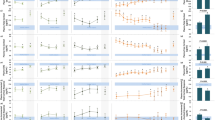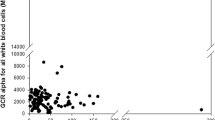Abstract
There is increasing evidence that the hypercortisolemia in inflammatory diseases suppresses the elaboration of proinflammatory cytokines, thus protecting the host from its own defence reactions. In severe sepsis and septic shock cortisol levels are usually elevated, but some patients may have relative adrenal insufficiency. This may contribute to the overwhelming systemic inflammatory response syndrome. We evaluated the impact of low-dose hydrocortisone infusion (10 mg/h) on the course of the systemic inflammatory response syndrome. This dose corresponds to a maximum secretory rate of cortisol achieved in corticotropin-stimulated healthy humans. In a prospective observational study 57 surgical patients with severe sepsis or septic shock were studied, of which in addition to the conventional treatment 12 patients were infused with low-dose hydrocortisone, and 45 were treated without any corticosteroid. In the longitudinal analysis the systemic inflammatory response — as judged by body temperature, cardiovascular response, and kinetics of inflammatory mediators such as phospholipase A2, C-reactive protein, and neutrophil elastase — started to differ in favor of the hydrocortisone-treated patients after 2 days of treatment (P < 0.05, Mann-Whitney U test). The difference disappeared after withdrawal of exogenous cortisol. Shock reversal was achieved in all patients treated with low-dose hydrocortisone. The data provide evidence that low-dose hydrocortisone infusion attenuates the systemic inflammatory response in human septic shock. From an immunological point of view a relative cortisol deficiency may contribute to the amplified immune response in systemic inflammatory diseases. A randomized clinical trial must clarify the impact of low-dose hydrocortisone infusion on the clinical course and outcome of septic shock patients.
Similar content being viewed by others
Abbreviations
- TNF:
-
Tumor necrosis factor
- PLA2 :
-
phospholipase A2
- CRP:
-
C-reactive protein
- E-PI:
-
neutrophil elastase-α1-proteinase inhibitor complex
- IL:
-
interleukin
References
Barber AE, Coyle SM, Fong Y, Fischer E, Marano MA, Calvano SE, Moldawer LL, Shires T, Lowry SF (1990) Impact of hypercortisolemia on the metabolic and hormonal responses to endotoxin in humans. Surg Forum 41:74–77
Barber AE, Coyle SM, Marano MA, Fischer E, Calvano SE, Fong Y, Moldawer LL, Lowry SF (1993) Glucocorticoid therapy alters hormonal and cytokine response to endotoxin in man. J Immunol 150:1999–2006
Billiau A, Vandekerckhove F (1991) Cytokines and their interactions with other inflammatory mediators in the pathogenesis of sepsis and septic shock. Eur J Clin Invest 21:559–573
Bone RC, Fisher CJ, Clemmer TP, Slotman GJ, Metz CA, Balk RA, the Methylprednisolone Severe Sepsis Study Group (1987) A controlled clinical trial of high-dose methylprednisolone in the treatment of severe sepsis and septic shock. N Engl J Med 317:653–658
Briegel J, Forst H, Hellinger H, Haller M (1991) Contribution of cortisol deficiency to septic shock. Lancet 338:507–508
Dawson-Saunders B, Trapp RG (1990) Estimating & comparing means. In: Basic and clinical biostatistics. Appleton & Lange, San Mateo Norwalk, pp 99–123
Dinarello CA, Wolff SM (1990) Pathogenesis of fever. In: Mandell GL, Douglas RG, Bennett JE (eds) Infectious diseases. Churchill Livingstone, New York Edinburgh London, pp 462–467
Duswald K-H, Jochum M, Schramm W, Fritz H (1985) Released granulocytic elastase: an indicator of pathobiochemical alterations in septicemia after abdominal surgery. Surgery 98:892–899
Elebute EA, Stoner HB (1983) The grading of sepsis. Br J Surg 70:29–31
Finlay WEI, McKee JI (1982) Serum cortisol levels in severely stressed patients. Lancet 1:1414–1415
Goulding NJ, Guyre PM (1993) Glucocorticoids, lipocortins and the immune response. Curr Opin Immunol 5:108–113
Hoffmann GE, Neumann U (1989) Modified photometric method for the determination of phospholipase A activities. Klin Wochenschr 67:106–109
Lin L-L, Lin AY, Knopf JL (1992) Cytosolic phospholipase A2 is coupled to hormonally regulated release of arachidonic acid. Proc Natl Acad Sci USA 89:6147–6151
Munck A, Guyre PM, Holbrook NJ (1984) Physiological functions of glucocorticoids in stress and their relation to pharmacological actions. Endocr Rev 5:25–44
Peers SH, Smillie F, Elderfield AJ, Flower RJ (1993) Glucocorticoid-and non-glucocorticoid induction of lipocortins (annexins) 1 and 2 in rat peritoneal leucocytes in vivo. Br J Pharmacol 108:66–72
Pruzanski W, Vadas P (1991) Phospholipase A2 — a mediator between proximal and distal effectors of inflammation. Immunology Today 12:143–146
Pruzanski W, Stefanski E, Wilmore DW, Martich GD, Hoffman AGD, Suffredini AF, Vadas P (1990) Sequential activation of TNF-phospholipase A2 axis following i.v. endotoxin challenge in human vounteers. FASEB J 4:A1714
Redl H, Schlag G, Schiesser A, Davies J (1993) Tumor necrosis factor is a mediator of phospholipase release during bacteremia in baboons. Am J Physiol Heart Circ Physiol 264:H2119-H2123
Rees AJ, Lockwood CM (1993) Immunosuppressive drugs in clinical practice. In: Lachmann PJ, Peters K, Rosen FS, Walport MJ (eds) Clinical aspects of immunology. Blackwell, London, pp 929–969
Rothwell PW, Udwadia ZF, Lawler PG (1991) Cortisol response to corticotropin and survival in septic shock. Lancet 337:582–583
Santos AA, Scheltinga MR, Lynch E, Brown EF, Lawton P, Chambers E, Browning J, Dinarello CA,Wolff SM, Wilmore DW (1993) Elaboration of interleukin 1-receptor antagonist is not attenuated by glucocorticoids after endotoxemia. Arch Surg 128:138–144
Schneider AJ, Voerman HJ (1991) Abrupt hemodynamic improvement in late septic shock with physiological doses of glucocorticoids. Intensive Care Med 17:436–437
Spinas GA, Bloesch D, Keller U, Zimmerli W, Cammisuli S (1991) Pretreatment with ibuprofen augments circulating tumor necrosis factor α, interleukin-6, and elastase during acute endotoxinemia. J Infect Dis 163:89–95
Sprung CL, Caralis PV, Marcial EH, Pierge M, Gelbard MA, Long WM, Duncan RC, Tendler MD, Karpf M (1984) The effects of high-dose corticosteroids in patients with septic shock. N Engl J Med 311:1137–1143
Thomas JP, El-Shaboury AH (1971) Aldosterone secretion in steroid-treated patients with adrenal suppression. Lancet 1:623–625
Vadas P, Pruzanski W, Stefanski E, Ruse J, Farewell V, McLaughlin J, Bombardier C (1988) Concordance of endogenous cortisol and phospholipase A2 levels in gram-negative septic shock: a prospective study. J Lab Clin Med 111:584–590
Vadas P, Pruzanski W, Stefanski E, Sternby B, Mustard R, Bohnen J, Fraser I, Farewell V, Bombardier C (1988) Pathogenesis of hypotension in septic shock: correlation of circulating phospholipase A2 levels with circulatory collapse. Crit Care Med 16:1–7
Van den Bosch H, Schalkwijk C, Pfeilschifter J, Märki F (1992) The induction of cellular group II phospholipase A2 by cytokines and its prevention by dexamethasone. Adv Exp Med Biol 318:1–10
Veterans Administration Systemic Sepsis Cooperative Study Group (1987) Effect of high-dose glucocorticoid therapy on mortality in patients with clinical signs of systemic sepsis. N Engl J Med 317:659–665
Waage A, Bakke O (1988) Glucocorticoids suppress the production of tumor necrosis factor by lipopolysaccharide-stimulated human monocytes. Immunology 63:299–302
Zuckerman SH, Shellhaas J, Butler LD (1989) Differential regulation of lipopolysaccharide-induced interleukin 1 and tumor necrosis factor synthesis: effects of endogenous and exogenous glucocorticoids and the role of the pituitary-adrenal axis. Eur J Immunol 19:301–305
Author information
Authors and Affiliations
Consortia
Additional information
Correspondence to: J. Briegel
Rights and permissions
About this article
Cite this article
Briegel, J., Kellermann, W., Forst, H. et al. Low-dose hydrocortisone infusion attenuates the systemic inflammatory response syndrome. Clin Investig 72, 782–787 (1994). https://doi.org/10.1007/BF00180547
Received:
Revised:
Accepted:
Issue Date:
DOI: https://doi.org/10.1007/BF00180547




